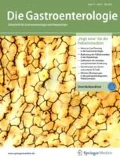Zusammenfassung
Die gastroösophageale Refluxkrankheit (GERD) besteht, wenn der Rückfluss von Mageninhalt störende Symptome und/oder Komplikationen verursacht. GERD ist eine Motilitätsstörung, die wesentlich durch eine geschwächte Barrierefunktion des unteren Ösophagussphinkters, eine verminderte Clearenceleistung der Speiseröhre bzw. eine verzögerte Magenentleerung bestimmt wird. Die Therapie mit Protonenpumpenhemmern ist effektiv, aber symptomatisch. Die aktuellen Empfehlungen der zurzeit gültigen aktuellen S2k-Leitlinie der Deutschen Gesellschaft für Gastroenterologie, Verdauungs- und Stoffwechselkrankheiten (DGVS) und der Montreal Klassifikation werden dargestellt.
Abstract
Gastroesophageal reflux disease (GERD) is defined by reflux of stomach contents causing bothering symptoms and/or complications. GERD is a motility disorder that comprises an impaired barrier function of the lower esophageal sphincter, a reduced clearance function of the esophagus, and impaired gastric emptying. Therapy by proton pump inhibitors is effective, but symptomatic. The current S2k guidelines of the Deutsche Gesellschaft für Gastroenterologie, Verdauungs- und Stoffwechselkrankheiten (DGVS) and the Montreal classification are presented.


Literatur
Koop H et al (2014) S2k-Leitlinie: Gastroösophageale Refluxkrankkheit. Z Gastroenterol 52:1299–1346
Vakil N, Zanten SV van, Kahrilas P et al (2006) The Montreal definition and classification of gastroesophageal reflux disease: a global evidencebased consensus. Am J Gastroenterol 101:1900–1920
Frieling T, Bergdoldt D, Allescher HD, Riemann JF (2015) Chest pain-not always the heart. Clinical impact of gastrointestinal diseases in non-cardiac chest pain. Z Gastroenterol 53:120–124
Frieling T, Kuhlbusch-Zicklam R, Weingardt C et al (2015) Klinische Wertigkeit von ösophagealen Funktionstests und Argonplasma Koagulation bei Magenschleimhautheterotypien im Ösophagus und extraesophagealen Reflux Symptomen – eine prospektive Untersuchung. Z Gastroenterol 53:101–107
Fullard M, Kang JY, Neild P et al (2006) Systematic review: does gastro-oesophageal reflux disease progress? Aliment Pharmacol Ther 24:33–45
Malfertheiner P, Nocon M, Vieth M et al (2012) Evolution of gastro-oesophageal reflux disease over 5 years under routine medical care – the Pro-GERD study. Aliment Pharmacol Ther 35:154–164
Ronkainen J, Talley NJ, Storskrubb T et al (2011) Erosive esophagitis is a risk factor for Barrett’s esophagus: a community-based endoscopic follow-up study. Am J Gastroenterol 106:1946–1952
Sontag SJ, Sonnenberg A, Schnell TG et al (2006) The long-term natural history of gastroesophageal reflux disease. J Clin Gastroenterol 40:398–404
Hvid-Jensen F, Pedersen L, Drewes AM et al (2011) Incidence of adenocarcinoma among patients with Barrett’s esophagus. N Engl J Med 365:1375–1383
Reimer C, Søndergaard B, Hilsted L, Bytzer P (2009) Proton-pump inhibitor therapy induces acid-related symptoms in healthy volunteers after withdrawal of therapy. Gastroenterology 137:80–87
McColl KE, Gillen D (2009) Evidence that proton-pump inhibitor therapy induces the symptoms it is used to treat. Gastroenterology 137:20–22
Forgacs I, Loganayagam A (2008) Overprescribing proton pump inhibitors. BMJ 336:2–3
Kassenärztliche Vereinigung Bayerns (2009) Protonenpumpeninhibitoren auf dem Vormarsch. Arzneimittel im Blickpunkt. Nr. 18/2009.
Pham CQ, Regal RE, Bostwick TR, Knauf KS (2006) Acid suppressive therapy use on an inpatient internal medicine service. Ann Pharmacother 40:1261–1266
Grant K, Al-Adhami N, Tordoff J et al (2006) Continuation of proton pump inhibitors from hospital to community. Pharm World Sci 28:189–193
Walker NM, McDonald J (2001) An evaluation of the use of proton pump inhibitors. Pharm World Sci 23:116–117
Bajaj JS, Zadvornova Y, Heuman DM et al (2009) Association of proton pump inhibitor therapy with spontaneous bacterial peritonitis in cirrhotic patients with ascites. Am J Gastroenterol 104:1130–1134
Campbell MS, Obstein K (2008) Association between proton pump inhibitor use and spontaneous bacterial peritonitis. Dig Dis Sci 53:394–398
Northup PG, Sundaram V, Fallon MB et al (2008) Hypercoagulation and thrombophilia in liver disease. J Thromb Haemost 6:2–9
Merwat SN, Spechler SJ (2009) Might the use of acid-suppressive medications predispose to the development of eosinophilic esophagitis? Am J Gastroenterol 104:1897–1902
Prasad GA, Alexander JA, Schleck CD et al (2009) Epidemiology of eosinophilic esophagitis over 3 decades in Olmsted County, Minnesota. Clin Gastroenterol Hepatol 7:1055–1061
Einhaltung ethischer Richtlinien
Interessenkonflikt. T. Frieling gibt an, dass kein Interessenkonflikt besteht.
Dieser Beitrag beinhaltet keine Studien an Menschen oder Tieren.
Author information
Authors and Affiliations
Corresponding author
Rights and permissions
About this article
Cite this article
Frieling, T. Diagnostik und Therapie der gastroösophagealen Refluxerkrankung. Gastroenterologe 10, 213–224 (2015). https://doi.org/10.1007/s11377-015-1012-x
Published:
Issue Date:
DOI: https://doi.org/10.1007/s11377-015-1012-x

